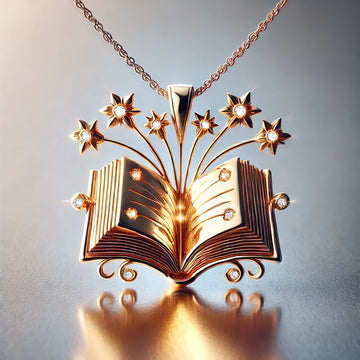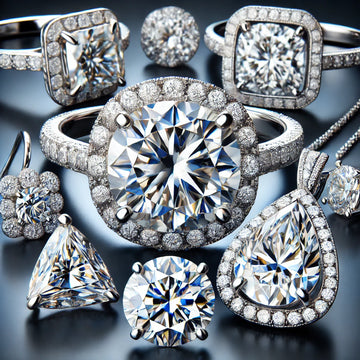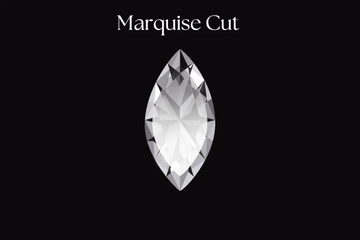Jewelry Essentials: Learning the Language of Metals and Gems
by Keyur Koshiya on Oct 18, 2024

https://ivevar.com/products/customized-yellow-gold-moissanite-diamond-bracelet-ivevar
1. The History of Jewelry
Jewelry’s origins can be traced back to prehistoric times when early humans adorned themselves with simple items such as bones, shells, and stones. Over time, jewelry became more sophisticated and a powerful indicator of status, wealth, and power across various cultures.
- Ancient Egypt : Jewelry was highly symbolic in ancient Egypt, where gold was particularly revered due to its association with the gods. Egyptians wore ornate pieces of jewelry, including amulets, necklaces, and bracelets, often inlaid with gemstones such as turquoise, lapis lazuli, and carnelian. Jewelry also played a role in the afterlife, with burial rites involving elaborate jewelry for the dead.
- Mesopotamia : In Mesopotamian civilization, jewelry was worn by both men and women and was made from gold, silver, and copper. Their jewelry featured natural motifs, such as leaves, grapes, and spirals, reflecting their surroundings. The use of colored stones such as agate and lapis lazuli was prominent.
- Ancient Greece and Rome : Jewelry in ancient Greece was primarily decorative but also had religious and symbolic meanings. The Greeks excelled in intricate metalwork, using gold, silver, and bronze. Roman jewelry, influenced by Greek styles, became an expression of social status. They incorporated gemstones like emeralds, pearls, and diamonds into their designs, and their use of cameos and intaglios (engraved gems) was particularly notable.
- Middle Ages and Renaissance : During the Middle Ages, jewelry became a symbol of nobility and power, worn by royalty and the upper class. Materials such as gold, silver, and precious gems were used in abundance. The Renaissance period saw a resurgence of interest in art and craftsmanship, with jewelry becoming more ornate and complex, often depicting religious or mythological themes. Gemstones were cut and polished to enhance their beauty, and the use of enameling techniques flourished.
- 19th and 20th Century : The Victorian era marked a period of romantic and sentimental jewelry, often featuring motifs such as hearts, flowers, and lockets. During this time, mass production of jewelry became possible due to advancements in technology. The discovery of diamond mines in South Africa in the late 19th century led to the popularity of diamond jewelry, especially engagement rings. The 20th century saw diverse movements, from the geometric Art Deco style of the 1920s to the bold, innovative designs of the 1960s and beyond.
2. Types of Jewelry
Jewelry is categorized into different types based on the body part it adorns or its specific function. Below are some common types of jewelry:
- Rings : Rings are worn on the fingers and can range from simple bands to elaborate designs featuring gemstones. Engagement rings, wedding bands, and signet rings are some of the most significant types of rings.
- Necklaces : Necklaces are worn around the neck and vary in length, style, and material. They may include pendants, lockets, or be layered with multiple chains for a dramatic effect.
- Bracelets : Bracelets are worn around the wrist and can be made from metal, beads, or leather. Bangles, cuffs, and charm bracelets are popular styles.
- Earrings : Earrings are worn on the earlobes, and styles include studs, hoops, and dangles. Earrings can feature a range of gemstones and metals, adding elegance or boldness to any outfit.
- Brooches and Pins : Brooches and pins are decorative pieces worn on clothing, often used as statement pieces. While less common today, they were once a staple of formal wear.
- Anklets : Anklets are worn around the ankle and are more common in certain cultures. They can be simple chains or decorated with charms and beads.
- Cufflinks : Cufflinks are worn by men with formal shirts and are often made from precious metals or gemstones.
- Tiara and Crowns : Tiaras and crowns are worn on the head, typically reserved for special occasions like weddings, coronations, or other formal events.
3. Gemstones: Nature's Precious Gifts
Gemstones are an integral part of jewelry, and understanding their properties is crucial for appreciating jewelry craftsmanship. Gemstones are divided into two categories: precious and semi-precious.
- **Precious Gemstones**: These include diamonds, rubies, sapphires, and emeralds. They are rare, highly valuable, and often used in high-end jewelry.
- Diamonds : Known for their brilliance and durability, diamonds are the most popular choice for engagement rings. Diamonds are graded based on the four Cs: Cut, Color, Clarity, and Carat weight, all of which determine their value and appearance.
- Sapphires : Typically blue but available in many colors, sapphires symbolize loyalty and are used in engagement rings and fine jewelry.
- Rubies : Known for their rich red color, rubies represent passion and love. They are highly valued for their vibrant hue and durability.
- Emeralds : Prized for their lush green color, emeralds symbolize rebirth and growth. However, they are softer and more prone to damage compared to diamonds or sapphires.
- Semi-Precious Gemstones : These include amethyst, garnet, aquamarine, opal, peridot, and turquoise. Though less valuable than precious stones, they are admired for their variety of colors and properties.
- Amethyst : A beautiful purple stone, amethyst is often associated with calmness and spirituality.
- Aquamarine : This light blue gemstone is known for its association with tranquility and the sea.
- Opal : Opal is known for its play of color, with flashes of blue, green, and red. It is delicate and often used in unique, artistic jewelry pieces.
4. Metals in Jewelry Making
Metals form the backbone of most jewelry, providing structure and durability. Understanding the different types of metals is key to selecting the right piece of jewelry.
- Gold : One of the most popular and versatile metals in jewelry, gold is valued for its beauty and resistance to tarnish. It comes in various purities (measured in karats), with 24k being pure gold. However, pure gold is soft, so it is often alloyed with other metals for durability. Gold is available in different colors, including:
- Yellow Gold : Traditional and classic, yellow gold is a blend of pure gold with copper and zinc.
- White Gold : Made by alloying gold with metals such as palladium or nickel, white gold has a silvery appearance. It is often coated with rhodium for extra shine.
- Rose Gold : Rose gold gets its pinkish hue from copper alloy. It has gained popularity for its romantic and vintage appeal.
- Platinum : A dense, durable metal, platinum is often used in fine jewelry, particularly for engagement and wedding rings. It is naturally white, hypoallergenic, and resistant to tarnishing.
- Silver : Sterling silver is an alloy made from 92.5% pure silver and 7.5% copper. It is more affordable than gold or platinum but requires more maintenance due to its tendency to tarnish.
- Palladium : Palladium is a member of the platinum family and is prized for its strength and silvery-white appearance. It is lighter and less expensive than platinum but shares its resistance to tarnishing.
5. Jewelry Craftsmanship
Jewelry making is an art that requires precision, skill, and creativity. There are various techniques and methods that jewelers use to create stunning pieces, including:
- Casting : In casting, molten metal is poured into a mold to create the desired shape. This is one of the most common methods used to produce metal jewelry.
- Stone Setting : Stone setting refers to the method of securing gemstones into the jewelry piece. Popular settings include prong, bezel, and pavé, each providing a different aesthetic and level of security.
- Engraving : Engraving involves carving designs or initials into the metal surface of jewelry, adding a personal touch or intricate detail.
- Enameling : Enameling involves fusing colored glass onto the metal surface, creating vibrant and durable designs.
- **Filigree**: This intricate technique involves twisting and weaving fine threads of metal to create lace-like patterns. Filigree is often used in vintage or antique-style jewelry.
6. Jewelry Trends and Styles
Jewelry trends evolve over time, influenced by cultural shifts, technological advancements, and fashion movements. Some notable trends and styles include:
- Vintage and Antique Jewelry : Many people are drawn to vintage or antique jewelry for its unique craftsmanship and history. Art Deco jewelry, characterized by geometric shapes and bold designs, remains popular.
- Minimalist Jewelry : In contrast to ornate designs, minimalist jewelry focuses on clean lines and simple shapes. Delicate necklaces, thin rings, and understated earrings dominate this trend.

 Engagement Ring
Engagement Ring  Anniversary Rings
Anniversary Rings Solitaire Rings
Solitaire Rings Halo Rings
Halo Rings Men's Ring
Men's Ring Toi Moi Ring
Toi Moi Ring Three Stone Rings
Three Stone Rings Nature Inspired Rings
Nature Inspired Rings Rose Cut Diamond Rings
Rose Cut Diamond Rings Fancy Color Rings
Fancy Color Rings Antique Cut Diamond Rings
Antique Cut Diamond Rings Wedding rings
Wedding rings All Lab Grown Diamond Ring
All Lab Grown Diamond Ring Engagement Ring
Engagement Ring  Three Stone Rings
Three Stone Rings Daily Wear
Daily Wear Fancy Color Rings
Fancy Color Rings Antique Cut Diamond Rings
Antique Cut Diamond Rings Earrings
Earrings Bracelet
Bracelet Pendent
Pendent Necklace
Necklace Men's Ring
Men's Ring Bridal Sets
Bridal Sets Rings
Rings Earrings
Earrings Tennis chain
Tennis chain Custom Pendent
Custom Pendent Custom Ring
Custom Ring Custom Teeth Grillz
Custom Teeth Grillz Round
Round Oval
Oval Cushion
Cushion Marquise
Marquise Pear
Pear Emerald
Emerald Heart
Heart Princess
Princess Rose Cut
Rose Cut Radiant
Radiant Antique Cut
Antique Cut



